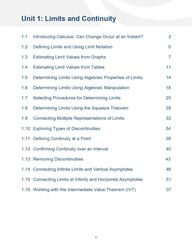
Return to flip book view
Message 1 Unit 1: Limits and Continuity 1.1 Introducing Calculus: Can Change Occur at an Instant? 2 1.2 Defining Limits and Using Limit Notation 5 1.3 Estimating Limit Values from Graphs 7 1.4 Estimating Limit Values from Tables 11 1.5 Determining Limits Using Algebraic Properties of Limits 14 1.6 Determining Limits Using Algebraic Manipulation 18 1.7 Selecting Procedures for Determining Limits 25 1.8 Determining Limits Using the Squeeze Theorem 28 1.9 Connecting Multiple Representations of Limits 32 1.10 Exploring Types of Discontinuities 34 1.11 Defining Continuity at a Point 38 1.12 Confirming Continuity over an Interval 40 1.13 Removing Discontinuities 43 1.14 Connecting Infinite Limits and Vertical Asymptotes 46 1.15 Connecting Limits at Infinity and Horizontal Asymptotes 51 1.16 Working with the Intermediate Value Theorem (IVT) 57
Unit 1: Limits and Continuity 2 Topic 1.1 Introducing Calculus: Can Change Occur at an Instant? Limits Calculus depends on the concept of a limit, which is the process of getting arbitrarily close to a point without reaching that point. A limit examines the behavior of a function as the dependent variable x gets very close to a value c. If the function approaches a particular value L as x approaches c, then the limit equals L. An important concept in calculus involves using a limit to examine the behavior of the average rate of change of a function over an interval as the interval gets smaller and smaller. Average Rate of Change The average rate of change (AROC) of a function over an interval is the average amount that the function changes over the length of the interval. It is given by the total change in the function divided by the total change in the interval. For a function f(x), the AROC over [a, b] is given by =, which also gives the slope of the secant line between the points (a, f(a)) and (b, f(b)).
Unit 1: Limits and Continuity 3 Instantaneous Rate of Change Consider a car that accelerates from 0 miles per hour to 30 miles per hour over an interval of time. The AROC in the car's position gives the average speed of the car during the interval. In contrast, the instantaneous rate of change (IROC) gives the exact speed of the car at a particular instant of time within the interval. The IROC at a particular instant c corresponds to the limit of the AROC as the endpoints of the interval [a, b] each approach c.
Unit 1: Limits and Continuity 4 1.1 Check for Understanding 1. What is the average rate of change in the function f(x) = x2 − 2x + 4 over the interval [1, 3] ? A. 2 B. 3 C. 4 D. 7 2. The graph of a function f is shown above. What is the average rate of change in f over the interval [0, 2] ? A. !" B. "! C. 2 D. 3
Unit 1: Limits and Continuity 5 Topic 1.2 Defining Limits and Using Limit Notation Limit Notation The limit of a function f as x approaches a value c is denoted as →(). This limit examines the behavior of f as x gets closer to c from both sides. If the function f approaches a particular value L as x approaches c, then →()= . Example The limit as x approaches 4 of √ is denoted as follows: The remaining topics in this unit discuss how to evaluate limits, which will provide the tools to find that lim$→%√= 2. The graph below shows how a limit can be expressed graphically. Note: The limit considers values of x close to 4 on both the left and right sides but does not include x = 4.
Unit 1: Limits and Continuity 6 1.2 Check for Understanding 1. As values of x get closer to 4, the values of a function h get closer to 1. Which of the following equations models this information? A. lim!(#)→& = 4 B. lim!(#)→' = 1 C. lim#→&ℎ()= 4 D. lim#→'ℎ()= 1 2. Which of the following sentences translates the equation →(− )= − ? A. As x approaches −2, 3x − 5 approaches 1. B. As x approaches 1, 3x − 5 approaches −2. C. As 3x − 5 approaches −2, x approaches 1. D. As 3x − 5 approaches 1, x approaches −2.